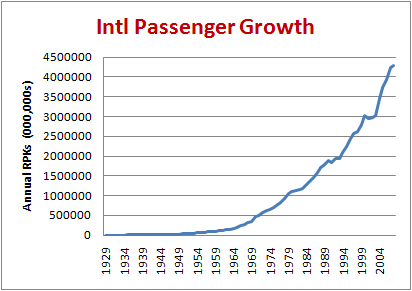Airline Competition 1980-2010 R.I.P.
Part 4 : The demonstrated lack of
growth in airlines to date
|
|
You can see below the
growth in passenger numbers, this chart (source) shows the growth in
airplanes in airline fleets from 1965 - 1999.
Part of a series on airline competition
- see extra articles listed in the right hand column. |
One of the curious and
contradictory things about the airline industry is that its
basic fundamentals are enormously positive. There is a
huge growth in passenger numbers and passenger miles flown, both
domestically and internationally.
But somehow, airlines lose as
much money as they ever make, and while passenger numbers and
airplane numbers double, airline numbers reduce rather than
increase.
Airline History - A
Demonstrated Failure of Competition
There's plenty of
hypothetical stuff in the preceding articles in this series, and
unavoidably, some
over-simplifications too. Our hypothesis is simple - that
airline competition, at least across the Atlantic, is now dead,
and that competition within the US is on life-support and dying.
How to confirm (or refute)
this hypothesis? The next article looks into the future,
but to start with, let's look at what has happened in the past.
As a startling initial point
of reference, in the 30 odd years since deregulation in the US,
about 200 US airlines have merged, been taken over, or gone out
of business (this includes many new startup carriers that have
come and gone).
Here's a
staggeringly long list of 370 airlines, dating back most of
the way to the start of the airline industry, that have gone out
of business in some form or another and which no longer exist in
the US. It is probably not complete. The airline
industry in the US is not quite 90 years old, so that suggests
as many as 4.5 airlines every year are going out of business.
The good news is that
clearly some airlines have been starting up over the last
decades, but the bad news is that, equally clearly, most are not
surviving and growing into major competitive forces.
Let's look at all airlines
in the US with a 1% or greater market share (using the same
Bureau of Transportation Statistics data used
here) and see when each
of them was founded.
Founding dates of US
Passenger Airlines
|
Rank |
Airline |
Market
Share % |
Date Founded |
|
1 |
Delta & Northwest |
21.8 |
1924 |
|
2 |
American |
15.2 |
1930 |
|
3 |
United |
13.0 |
1926 |
|
4 |
Continental |
10.1 |
1931 |
|
5 |
Southwest |
9.3 |
1971 |
|
6 |
US
Airways |
7.4 |
1939 |
|
7 |
JetBlue |
3.3 |
1998 |
|
8 |
AirTran |
2.4 |
1992 |
|
9 |
Alaska |
2.4 |
1932 |
|
10 |
SkyWest |
1.5 |
1972 |
|
11 |
Frontier (now part of Republic) |
1.1 |
1994
- 2009 |
|
12 |
ExpressJet |
1.0 |
1986 |
|
13 |
Hawaiian |
1.0 |
1929 |
|
17 |
Virgin America |
0.7
|
2007
|
|
To summarize, of the
thirteen US carriers of any meaningful size at all :
-
The four largest were all
formed in the first decade of commercial aviation in the US.
-
More than half (seven) were
formed before World War 2.
-
None of them were
formed in the 1940s.
-
None of them were formed in
the 1950s.
-
None of them were formed in
the 1960s.
-
Two were formed in the 1970s
(both prior to deregulation).
-
One was formed in the 1980s.
-
Three were formed in the
1990s, one of which is already no longer in business
-
None of the airlines formed in
the 2000s have grown to the top 13 list
That is hardly the picture
of a vibrant airline industry, is it, and is all the more
bizarre when contrasted with the growth of air travel.
The following tables are
from the
Air Transport Association.

As you can see, half of all
growth in US air travel has occurred in the last 25 years.
The growth is even steeper
and more recent for international passengers.

As you can see from this
chart, half of all international travel has occurred in the last
some 15 years.
You'd normally expect these
extraordinary rates of growth to be marked by some degree of
growth of
airlines too. With the huge leaps upwards in passenger
numbers,
surely new airlines couldn't help but succeed, right? Even
if the existing airlines kept all their existing customers,
there's still enough new business to allow a doubling in
airlines. Doesn't a rising tide lift all boats?
Especially when one factors
in the apparent complete lack of economy of scale benefit as
airlines get larger, the stark absence of an explosion in
airline numbers to match the same explosion in passenger numbers
becomes a point of significance.
Something (possibly unfair
competition?) is preventing more airlines from starting and
surviving.
Lessons from Virgin America's
Slow Growth?
In the table above, I also
list the ranking for the one recent airline startup that shows
promise for the future - Virgin America. This airline is
only sort of a startup, due to its linkage to Sir Richard
Branson and his various other Virgin branded airlines around the
world, so it has plenty of parentage, while being a genuinely
new entrant into the US market.
Although now in its third
year of operation, it still has yet to win even a 1% market
share, whether by market growth or market share capture.
There are lots of reasons
why Virgin America is not growing as quickly as one would expect
(or as quickly as they would expect, either), most obvious of
which are the tough economic times. But while tough
economic times might diminish a new airline's ability to grow by
way of expanding the market as a whole, it doesn't impact
on a new airline's ability to grow by way of simply taking
market share from other airlines.
There are very few
people who like and are voluntarily loyal to any airline for
'good' reasons, but as we can see from Virgin America's very slow
growth, even a well run innovative and fairly priced new carrier
such as Virgin America is struggling to compete against the
massive megolithic carriers it flies against.
Growth Primarily by Merger and
Acquisition
Let's now consider one other
point. Confining ourselves to the 10 largest carriers,
let's see how many of those have grown, at least to some extent,
by acquisition or merger with other airlines, as compared to
those that started from scratch and grew 'organically'.
This table of merged
airlines is incomplete, because some of the airlines that merged
into the surviving top ten carriers are themselves the
product/sum of previous mergers. It is intended merely to
indicate that the bigger the airline, the more its growth has
come from mergers and acquisitions, and the less its growth
reflects deserved success and strength in the marketplace.
US Airline Merger
Participation
|
Rank |
Airline |
Mergers |
|
1 |
Delta & Northwest |
Chicago & Southern, (some of) Midwest,
Northeast, Northwest, (some of) Pan Am,
Republic, Western, failed to invest in
JAL, failed to buy Continental |
|
2 |
American |
Was
formed out of 82 (!) smaller airlines to
start with. Air California, (some of)
Eastern, (some of) Pan Am, Reno Air,
Trans Caribbean, TWA, failed to invest
in JAL |
|
3 |
United |
(share of) Aloha, Boeing Air Transport,
Capital Airlines, National Air
Transport, (some of) Pan Am, has been
(rumored) to have been in merger
discussions with US Airways and
Continental |
|
4 |
Continental |
Frontier (1986), New York Air, People
Express, Pioneer, Texas International,
failed to merge with United (so far) |
|
5 |
Southwest |
Morris Air, Muse Air, ATA Airlines,
failed to acquire Frontier |
|
6 |
US
Airways |
Allegheny, America West, Empire, Lake
Central, Mohawk, Piedmont, PSA, Trump
Shuttle, failed to merge with United,
failed to merge with Delta |
|
7 |
JetBlue |
None, but now 19% owned by Lufthansa |
|
8 |
AirTran |
ValuJet. Failed to buy Midwest
Airlines. |
|
9 |
Alaska |
Horizon, Jet America, various small
airlines in Alaska, |
|
10 |
SkyWest |
Atlantic Southeast, Sun Aire |
|
Why Aren't Airline Numbers
Increasing
We're told (by the airlines)
that there is a natural and inevitable trend towards airline
consolidation, and that various countries and regions can't
sustain the current numbers of airlines operating.
Such claims are nonsense for
three reasons.
1. There's no evidence
that bigger airlines are more efficient or more profitable than
small airlines. Indeed,
our analysis here
suggests quite the opposite. Smaller airlines have lower
costs and better profits.
2. Airline numbers
have been artificially controlled and limited, particular on
international routes, for many years. One would consider
that with these artificial limits and constraints being removed,
there would be a rush of new airlines appearing, not the
opposite.
3. Look again at the
two charts above. Air traffic has doubled in the last 15
years (internationally) and the last 25 years (domestically).
Surely twice as many passengers would mean that the rapidly
growing market for air travel can at least sustain the same
number of airlines as before. Maybe there's not a need to
double the number of airlines to match the doubled number of
passengers, but is there a need to halve and halve and halve
again the remaining number of different airline entities?
The Impossible Challenge For
New Airlines
Clearly, something is
preventing new airlines from succeeding, even though the market
as a whole is growing in leaps and bounds.
Please see the next part of
our series for analysis of what these impediments to success may
be.
Part of a series on airline competition
- please see extra articles listed at the top in
the right hand column
Related Articles, etc
|
If so, please donate to keep the website free and fund the addition of more articles like this. Any help is most appreciated - simply click below to securely send a contribution through a credit card and Paypal.
|
Originally published
12 Mar 2010, last update
30 May 2021
You may freely reproduce or distribute this article for noncommercial purposes as long as you give credit to me as original writer.
|

